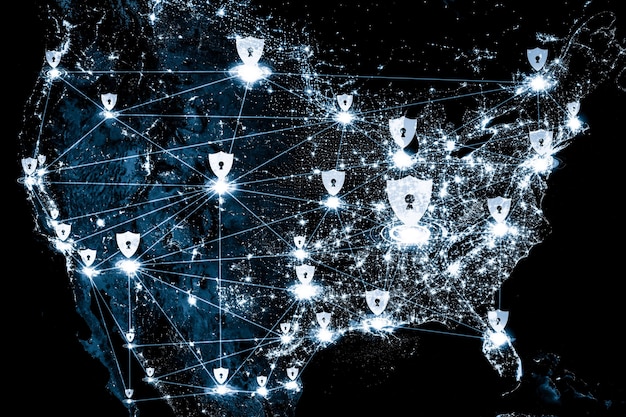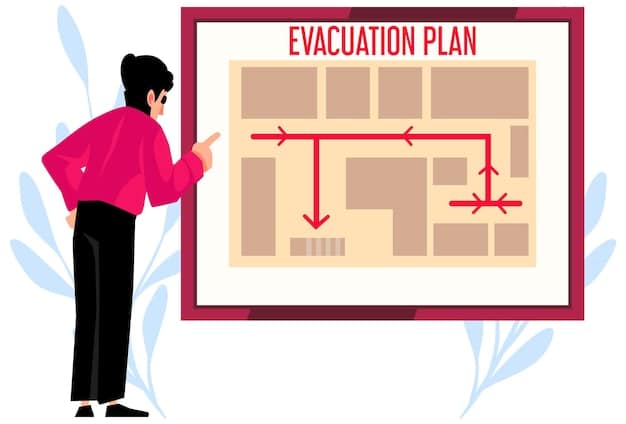DHS Cybersecurity Directives 2025: Is Your Company Ready?

Is Your Company Prepared? New DHS Cybersecurity Directives for 2025 are set to reshape the cybersecurity landscape, mandating stringent measures for critical infrastructure entities, and organizations must proactively enhance their defenses against evolving cyber threats to ensure compliance and resilience.
The cybersecurity landscape is constantly evolving, and with it, so are the regulations and directives designed to protect critical infrastructure. As we approach 2025, organizations across the United States need to be aware of and prepared for the new **DHS Cybersecurity Directives for 2025**. These directives, spearheaded by the Department of Homeland Security (DHS), aim to bolster the nation’s cyber defenses against increasingly sophisticated threats.
Understanding the Impetus Behind the New DHS Directives
The introduction of new cybersecurity directives by the DHS is not an arbitrary exercise. It stems from a growing recognition of the increasing sophistication and frequency of cyberattacks targeting American infrastructure and businesses. Understanding the underlying reasons for these directives can help organizations better appreciate their importance and prepare accordingly.
The Rising Tide of Cyber Threats
Cyber threats have evolved from simple malware attacks to complex, state-sponsored campaigns. These threats can disrupt essential services, compromise sensitive data, and inflict significant financial damage. The DHS directives are a proactive response to this evolving threat landscape.
Protecting Critical Infrastructure
Critical infrastructure, including energy, transportation, and communication networks, is particularly vulnerable to cyberattacks. Disruptions to these systems can have far-reaching consequences, affecting the economy, public safety, and national security. The directives prioritize the protection of these vital assets.

- Increased Sophistication: Modern cyberattacks employ advanced techniques, making them harder to detect and defend against.
- Expanded Attack Surface: The proliferation of connected devices and cloud services has expanded the potential attack surface for malicious actors.
- Geopolitical Tensions: Cyberattacks are increasingly used as tools of espionage and sabotage by nation-states, adding another layer of complexity to the threat landscape.
By understanding the factors driving the new DHS directives, organizations can better appreciate the need for robust cybersecurity measures and proactively prepare for compliance.
Key Components of the DHS Cybersecurity Directives for 2025
The DHS Cybersecurity Directives for 2025 encompass a range of requirements and recommendations designed to enhance the cybersecurity posture of organizations. These directives are not one-size-fits-all, and organizations should tailor their approach based on their specific circumstances and risk profiles.
Enhanced Cybersecurity Standards
The directives likely include stricter requirements for cybersecurity standards, such as the NIST Cybersecurity Framework. Organizations may need to implement more rigorous security controls and conduct regular risk assessments to ensure compliance.
Incident Reporting Requirements
The directives may also mandate stricter incident reporting requirements, requiring organizations to promptly report cybersecurity incidents to the DHS and other relevant authorities. This information helps the government track and respond to emerging threats.
Supply Chain Security
Recognizing the vulnerabilities inherent in supply chains, the directives may include provisions for managing cybersecurity risks associated with third-party vendors and suppliers. Organizations may need to implement due diligence processes and contractual requirements to ensure the security of their supply chains.

Understanding and implementing these key components is crucial for organizations seeking to comply with the new DHS Cybersecurity Directives for 2025 and protect themselves from cyber threats.
Steps Your Company Can Take to Prepare
Preparing for the new DHS Cybersecurity Directives for 2025 requires a proactive and comprehensive approach. Organizations should start by assessing their current cybersecurity posture and identifying any gaps in their defenses. From there, they can take steps to implement the necessary controls and procedures to ensure compliance.
Conduct a Comprehensive Risk Assessment
A risk assessment is the foundation of any good cybersecurity program. Organizations should conduct a thorough assessment of their assets, threats, and vulnerabilities to identify areas of concern. This assessment should be updated regularly to reflect changes in the threat landscape.
Implement the NIST Cybersecurity Framework
The NIST Cybersecurity Framework provides a comprehensive set of guidelines for managing cybersecurity risks. Organizations should use the framework to develop and implement a risk-based cybersecurity program.
Enhance Employee Training
Employees are often the weakest link in the cybersecurity chain. Organizations should provide regular training to employees on cybersecurity best practices, such as recognizing phishing emails and avoiding malware.
- Update Software Regularly: Keep all software, including operating systems and applications, up to date with the latest security patches.
- Implement Multi-Factor Authentication: Enable multi-factor authentication for all critical systems and accounts.
- Monitor Network Traffic: Implement network monitoring tools to detect and respond to suspicious activity.
- Develop an Incident Response Plan: Create a detailed plan for responding to cybersecurity incidents, including procedures for containment, eradication, and recovery.
By taking these steps, organizations can significantly improve their cybersecurity posture and better prepare for the new DHS Cybersecurity Directives for 2025. The **DHS Cybersecurity Directives for 2025** aim to protect businesses.
The Role of Technology in Meeting DHS Requirements
Technology plays a critical role in helping organizations meet the requirements of the new DHS Cybersecurity Directives for 2025. A variety of security tools and technologies are available to help organizations protect their assets, detect threats, and respond to incidents.
Security Information and Event Management (SIEM) Systems
SIEM systems collect and analyze security logs from various sources to identify potential threats. These systems can help organizations detect and respond to incidents in a timely manner. Implementing strategies is also something to consider when thinking about DHS directives.
Endpoint Detection and Response (EDR) Solutions
EDR solutions monitor endpoints for malicious activity and provide tools for investigating and responding to incidents. These solutions can help organizations protect their computers and servers from cyberattacks.
Vulnerability Management Tools
Vulnerability management tools scan systems for known vulnerabilities and provide recommendations for remediation. By identifying and addressing vulnerabilities, organizations can reduce their attack surface and prevent cyberattacks.
While technology is essential, it is not a silver bullet. Organizations must also implement strong policies and procedures and provide regular training to employees to create a comprehensive cybersecurity program. Keeping in mind that not all companies have the same measures in place, the new regulations may be a bigger change for some.
The Impact on Small and Medium-Sized Businesses (SMBs)
While the DHS Cybersecurity Directives for 2025 primarily target critical infrastructure entities, small and medium-sized businesses (SMBs) should also pay attention. SMBs are increasingly targeted by cyberattacks, and they may be held liable for breaches that compromise sensitive data. The reality of cybersecurity is that it affects many different institutions regardless of how large they may be.
Limited Resources
SMBs often have limited resources to invest in cybersecurity. They may lack the expertise and budget to implement sophisticated security controls. In fact, some smaller institutions may be unaware of the risks.
Supply Chain Vulnerabilities
SMBs are often part of larger supply chains, making them potential targets for attackers seeking to gain access to larger organizations. In this case, not just the company may be at risk.
Despite these challenges, SMBs can take steps to improve their cybersecurity posture. They can leverage cloud-based security services, implement basic security controls, and provide regular training to employees. Even smaller businesses should think about their own risk tolerance levels.
Future Trends in Cybersecurity and DHS Directives
The cybersecurity landscape is constantly evolving, and the DHS Cybersecurity Directives will likely continue to adapt to emerging threats and technologies. Staying informed about future trends can help organizations proactively prepare for the challenges ahead.
Artificial Intelligence (AI) and Machine Learning (ML)
AI and ML are being used to develop more sophisticated cyberattacks, but they can also be used to enhance cybersecurity defenses. AI-powered security tools can automate threat detection and response, making it easier for organizations to protect themselves.
Zero Trust Architecture
Zero trust is a security model that assumes that no user or device is inherently trustworthy. Organizations implementing zero trust architecture verify every user and device before granting access to resources. It is important to understand architecture to secure these infrastructures.
By staying informed about these trends, organizations can better anticipate future cybersecurity challenges and prepare for the evolving DHS directives. New techniques may be implemented for cybersecurity in the future meaning new approaches to these directives. Overall the **DHS Cybersecurity Directives for 2025** are extremely important and are there to protect businesses from cyberattacks.
| Key Point | Brief Description |
|---|---|
| 🛡️ Risk Assessment | Conduct thorough risk assessments to identify vulnerabilities. |
| 📚 NIST Framework | Implement the NIST Cybersecurity Framework for robust security. |
| 🧑💻 Employee Training | Enhance employee training to recognize and avoid cyber threats. |
| 🤖 AI & ML | Utilize AI and ML for advanced threat detection and response. |
Frequently Asked Questions
The DHS Cybersecurity Directives for 2025 are a set of regulations and guidelines from the Department of Homeland Security aimed at enhancing the cybersecurity posture of organizations, particularly those in critical infrastructure sectors, against evolving cyber threats.
Primarily, the directives affect critical infrastructure entities. However, given the interconnected nature of cyber threats, small and medium-sized businesses may also be indirectly impacted, especially those in the supply chains of larger organizations.
Companies can prepare by conducting thorough risk assessments, implementing the NIST Cybersecurity Framework, enhancing employee training, updating software regularly, and developing incident response plans to address potential security breaches.
Technology plays a crucial role. Security Information and Event Management (SIEM) systems, Endpoint Detection and Response (EDR) solutions, and vulnerability management tools are essential in protecting against and responding to cyber threats.
Future trends include the increasing use of Artificial Intelligence (AI) and Machine Learning (ML) in both cyberattacks and defenses, as well as the adoption of Zero Trust Architecture to enhance security by verifying every user and device before granting access.
Conclusion
The new DHS Cybersecurity Directives for 2025 represent a significant shift in the approach to cybersecurity, requiring organizations to take a more proactive and comprehensive approach to protecting their assets. By understanding the directives and taking steps to prepare, organizations can mitigate their risk of cyberattacks and ensure compliance with the new regulations.





